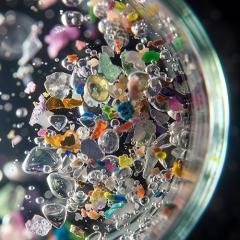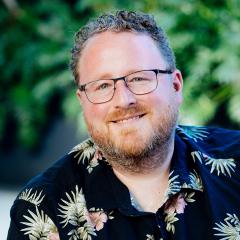QAEHS in Focus shines the spotlight on QAEHS staff and students to showcase the expertise and talent within our Centre. 
How long have you worked at QAEHS?
I started at QAEHS in January 2021, partway through the pandemic. I’d only just arrived in Brisbane, so the lockdowns and social distancing made finding a place to rent much more difficult than it needed to be, and it was strange to start a job with so few people around the building.
How do you explain your job to people?
I work on the Minderoo Project – Plastics and Human Health, where we are trying to understand what effects micro- and nanoplastics (MNPs) have on people. We have very little understanding of what MNPs do when they are in our body, where they go, if/how they are excreted, and if they have any long-term health effects. In my role, my main tasks are method development and sample processing. We are looking at different types of samples – urine, blood and brain being the main ones. With these, we are trying to see if MNPs exist in these samples, and to do so we need to be able to extract the MNPs out. I spend a lot of time working with samples to try and optimise extraction conditions and minimise potential contamination and interference sources. After processing samples, we look at the data and see what might be optimised or changed, and we repeat the modified experiment and go through the process again and again until we’ve got to the best state we can. Sometimes it can be tedious, but I find it enjoyable since there is always something new to learn that can be incorporated into other experiments and projects. On top of this I do a fair bit of procurement, and also help out with students.
What is your favourite thing about working at QAEHS?
While the people at QAEHS are absolutely wonderful, there is one specific thing that I really enjoy about working at QAEHS, and it is a bit of a strange one. I really enjoy working in the Minderoo Clean Lab on Level 6. It’s a very different space compared to the other laboratories in the building. It’s quiet, and when the lights in the airlock and anteroom shut off, it feels like you’re a million kilometres away from everyone else, which is, incidentally, one of the reasons we call it The Submarine. For me, it’s a calming and zen sort of space – everything is in its place, and everything just calmly goes with the flow (on a good day!).
Working there is a bit of an acquired taste though. Others find it very isolating, and when the helicopters fly over to go to the PA hospital it can become very noise and rattly.
What is something you learned in the last week?
I was watching a video on astronomy the other day and learned about Przybylski's Star (please don’t ask me to pronounce it!). It’s apparently a very unusual star because its spectrum shows it might contain elements that are rare/absent in other stars – rare-earth elements and short-lived radioactive isotopes. This might be just a false positive due to its magnetic field and rotation, or maybe there is some unknown process allowing these elements to be found in the star. It’s a big mystery, and the universe is a big place, so there will always be interesting things to discover, big or small.
What has been your career path that led to your current position at QAEHS?
It’s been a bit of a meandering path for me to get to QAEHS.
In high school I was really interested in forensic science. My undergraduate degree in Applied Chemistry in Forensic Science was at the University of Technology Sydney (UTS). At the end of my undergrad, I became interested in forensic toxicology, and eventually completed a PhD, exploring how people can use chemical additives to adulterate urine samples and confound confirmatory drug tests. At the end of my PhD I was still very interested in toxicology and chemistry, but at the time it was a bit of a struggle to find work in those fields. After some odd jobs and some other life things, I had the opportunity to join my husband in Sweden, where he had been offered a postdoc in archaeology at Stockholm University. From there, I was lucky to land an internship at the Department of Environmental Science and Analytical Chemistry (ACES), also at Stockholm University. I worked as a research assistant on a project investigating POPs (Persistent Organic Pollutants) in the Baltic Sea. From there I was hired to work as a research assistant on a few different projects regarding PFASs in environmental and human samples.
Whilst my husband and I thoroughly enjoyed living in Stockholm, and I was enjoying my work at ACES, the pandemic reared its ugly head and we were ultimately forced to move back to Australia. After a period in quarantine, and some time relaxing in Hervey Bay, I was lucky enough to hear about an upcoming job at QAEHS, studying microplastics – an area that I had no direct experience in or significant exposure to. The only snag was that the job application was due the next day, and by the time I’d heard about it, it was already the afternoon. Ultimately, I got the job, and thankfully I love my work at QAEHS. It was a steep learning curve at the start, but it’s all been worth it!
What is your favourite movie?
I love so many different genres, but Science Fiction and Horror are probably at the top of my list. It’s hard to pick an absolute favourite, but I’d have to go with Alien (1979). From the incredible acting of Sigourney Weaver, the amazing set designs, and the genuine suspense and terror that permeates the entire film, it’s definitely my favourite. In a very close second place would be Event Horizon (1997).
Random fact you would like to share about yourself.
I have a very strong sense of direction, so I find it difficult to get lost.



